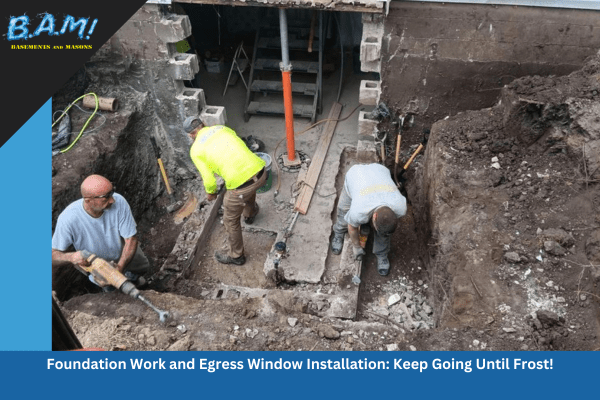About Best Basement Waterproofing
About Best Basement Waterproofing
Blog Article
The Best Strategy To Use For Best Basement Waterproofing
Table of ContentsThings about Best Basement WaterproofingAll about Best Basement WaterproofingGetting My Best Basement Waterproofing To WorkWhat Does Best Basement Waterproofing Mean?Not known Facts About Best Basement Waterproofing
uses excavation methods towards all-time low of the structure's foundation. includes getting rid of moisture after it has gone into the cellar. AdvantaClean's experienced experts and specialists will find the water resource. If wall surface or piece splits exist, we will certainly inject polyurethane and epoxies into the fractures and secure the concession, preventing further wetness from going into.If there's condensation outside of the aluminum foil, you have high humidity in your cellar. Fix it with a portable area dehumidifier or a whole-house humidifier system rather than waterproofing items. If the foil has condensation on the within surface (following to the wall), the dirt around your home may be normally damp from a high water table or poor dirt drainage.
You can waterproof simply your interior wall surfaces, which might fix the issue. Once they dry, they stick completely to concrete and masonry wall surfaces.
Unknown Facts About Best Basement Waterproofing
Swirl the brush at the last of application to provide the wall surface an eye-catching, ended up appearance. Concrete waterproof finishings can not be put on previously painted surfaces; check the label. A 5-gallon bucket costs about $60. Also called densifiers, they are suitable only for walls that have not been repainted or secured.
But you comb, roll, or spray it on a lot more thickly one gallon covers simply 75 square feet, not the 300 square feet normal with typical paint. Water resistant paint is fine for DIY application. You can use it over repainted surface areas, and paint over it once it's healed (one gallon costs $37).
It can cost $10,000 to $15,000, depending on the job needed. Outside waterproofing includes digging deep into all around the home to the complete depth of the structure wall surfaces, then mounting a water resistant finish or membrane layer topped by drain panels.
A cellar without waterproofing is kind of like Get the facts that. Your basement doesn't want to go with a rainstorm without proper protection just as much as you do not desire to.
How Best Basement Waterproofing can Save You Time, Stress, and Money.
However if you've done your research study, you would certainly know there are two kinds of waterproofing: exterior and interior. It can get puzzling what they both mean, which one's a much better investment, and what will in fact maintain the water out. Don't worry, we assembled this blog site to easily define both approaches for you and review the pros and disadvantages of each.
Outside waterproofing is a waterproofing technique that includes sealing your home from the outside. It's kind of like a moat around a castle. It involves digging a trench around your entire residence to the foundation (concerning 8 to 10 feet down). The structure wall surfaces are then cleansed, sealed, and covered with a waterproof membrane or sealant.

The Ultimate Guide To Best Basement Waterproofing
It's an extra involved procedure that needs digging up Best Basement Waterproofing your backyard, which is costly and time-consuming. Exterior waterproofing includes eliminating whatever surrounding the house, consisting of verandas, driveways, sidewalks, landscaping, AC units, decks, and more. If any one of the work was done improperly and water is still entering your cellar, there isn't much you can do to correct or repair it.
Inside basement waterproofing includes waterproofing from the within. Any kind of water that leaks right into your basement is redirected before it touches your floor. It's kind of like putting on a raincoat under your clothing. It includes two points: a water drainage track and a sump pump. It functions by securing the inside of your basement wall surfaces and floors so water that tries to enter is funnelled out through a sump pump.
It's an efficient technique to waterproof your basement - Best Basement Waterproofing. The disadvantage of interior basement waterproofing mostly concerns the setup procedure. This method requires saved products, furniture, and built-in shelving or cupboards to be moved from touching the basement walls. And throughout installment, your basement can not be used. The most significant distinction in between both techniques is this: Exterior waterproofing is a preventative option and indoor waterproofing is a rehabilitative option.
Best Basement Waterproofing Fundamentals Explained
To conclude, exterior and interior cellar waterproofing are both efficient approaches of shielding your home from water damage. Outside waterproofing produces an obstacle that protects against water from entering your home, while interior waterproofing redirects water that does enter your home. And it is necessary to keep in mind that exterior waterproofing is a pricey and disruptive installation process when compared to indoor waterproofing.
Whichever technique you choose, make sure you pick a trusted and credible contractor for the job. If you have any type of inquiries concerning cellar waterproofing, please reach out to us.
You can fill in our type right here, start a chat in the published here bottom right-hand edge, or call us at 1-800-827-0702.
Report this page